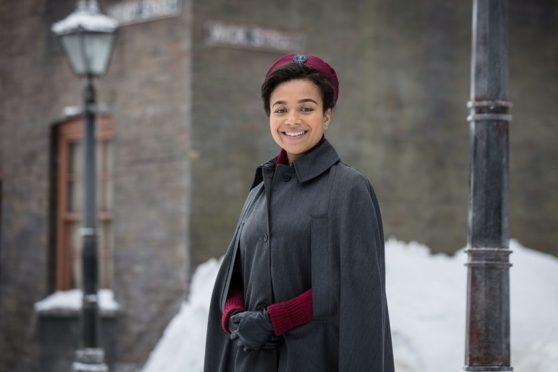Call The Midwife’s Leonie Elliott has said she hopes her new role as the show’s first West Indian nurse shines a light on the “unsung heroes” who came to the UK to work for the NHS.
The actress, 29, has joined the upcoming seventh series of the popular BBC drama as Lucille.
The programme’s creators have said the character will give an insight into the experience of Caribbean nurses who joined the NHS workforce in the 1960s.
Elliott said: “I’m just focused on doing her justice, and those kinds of women that came over at that time.
“I feel like they’re unsung heroes really, so just to shine a light on them.
“And hopefully the audience take to her and love her.”
VIDEO EXCLUSIVE! #callthemidwife series 7 introduces a brand new midwife to Nonnatus House – Nurse Lucille Anderson! @Leonie_Elliott and the team discuss the history behind our latest Nonnatun xx pic.twitter.com/676DKNLkpD
— Call The Midwife (@CallTheMidwife1) January 16, 2018
Elliott admitted it was tough shooting scenes where patients were hostile towards her character.
She said: “It’s quite difficult, just because I suppose that would have been some of the ladies’ experience when they came to London.
“And just speaking to my family as well, and just listening to some of their stories.
“So it is upsetting, but I think that it’s true to life in that it’s telling part of her story. It’s not all of her story, but it definitely is part of her experience.”
Writer Heidi Thomas said: “It was very interesting to develop Lucille’s character because obviously one has to address these issues of racial prejudice whether they’re personal or institutional, but Lucille is so much more than that.
“We look a lot at her experiences of settling into a strange culture, even finding a church that you feel happy in for example, and Lucille is sometimes quite old fashioned in her moral point of view, which is quite unusual, but I think it’s important that we see all those aspects of Lucille’s character.”
Elliott said it was exciting joining the midwives at Nonnatus House and working with small babies, describing filming birth scenes as “like a labour” itself.
“It is intense,” she said. “I suppose the actresses that are there are in it themselves so they do kind of grab onto you and hold onto you, so physically it’s quite demanding actually.
“But yes, it’s rewarding at the end, it definitely feels like we’ve accomplished something by the end of the day.
“And then we get to meet the baby and the baby’s always gorgeous and then it’s all worth it.”
Sunday night: Sorted. #CallTheMidwife returns to @BBCOne this Sunday at 8pm. 🙌 pic.twitter.com/U9GWgoVMOn
— BBC One (@BBCOne) January 16, 2018
Catching up with London’s East End in 1963, series seven will confront the nurses with everything from leprosy and Huntingdon’s Chorea to tokophobia (fear of pregnancy) and unmarried mothers.
As a building surge sees slums swapped for new tower blocks, romance between Trixie (Helen George) and Christopher (Jack Hawkins) blooms, while Nurse Crane (Linda Bassett) finds her authority unexpectedly challenged.
The new series comes after the programme won the Christmas Day ratings battle for the second year in a row, with an audience of 9.6 million people tuning in.
Call The Midwife returns to BBC One on Sunday, January 21.
